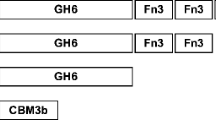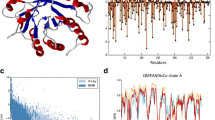Abstract
The non-catalytic, family 11 carbohydrate binding module (CtCBM11) belonging to a bifunctional cellulosomal cellulase from Clostridium thermocellum was hyper-expressed in E. coli and functionally characterized. Affinity electrophoresis of CtCBM11 on nondenaturing PAGE containing cellulosic polysaccharides showed binding with β-glucan, lichenan, hydroxyethyl cellulose and carboxymethyl cellulose. In order to elucidate the involvement of conserved aromatic residues Tyr 22, Trp 65 and Tyr 129 in the polysaccharide binding, site-directed mutagenesis was carried out and the residues were changed to alanine. The results of affinity electrophoresis and binding adsorption isotherms showed that of the three mutants Y22A, W65A and Y129A of CtCBM11, two mutants Y22A and Y129A showed no or reduced binding affinity with polysaccharides. These results showed that tyrosine residue 22 and 129 are involved in the polysaccharide binding. These residues are present in the putative binding cleft and play a critical role in the recognition of all the ligands recognized by the protein.
Similar content being viewed by others
References
Coutinho PM & Henrissat B (1999) Carbohydrate-active enzymes: An integrated database approach. Recent Advances in Carbohydrate Bioengineering (Gilbert, HJ, Davies, GJ, Henrissat, B and Svensson, B, eds) pp. 3–12, The Royal Society of Chemistry, Cambridge, UK
Gilbert HJ, Bolam DN, Szabo L, Xie H, Williamson MP, Simpson PJ, Jamal S, Boraston AB, Kilburn DG & Warren RA (2001) in Carbohydrate Bioengineering: Interdisciplinary Approaches (Teeri, T. T., Svensson, B., Gilbert, H. J., and Feizi, T., eds) pp. 89–98, The Royal Society of Chemistry, Cambridge, UK
Gill J, Rixon JE, Bolam DN, McQueen-Mason S, Simpson PJ, Williamson MP, Hazlewood GP & Gilbert HJ (1999) The type II and X cellulose-binding domains of Pseudomonas xylanase A potentiate catalytic activity against complex substrates by a common mechanism. Biochem J 342:473–480
Bolam DN, Ciruela A, McQueen-Mason S, Simpson P, Williamson MP, Rixon JE, Boraston A, Hazlewood GP & Gilbert HJ (1998) Pseudomonas cellulose-binding domains mediate their effects by increasing enzyme substrate proximity. Biochem J 331:775–781
Kraulis J, Clore GM, Nilges M, Jones TA, Petterson G, Knowles J & Gronenborn AM (1989) Determination of the three-dimensional solution structure of the C-terminal domain of cellobiohydrolase I from Trichoderma reesei. A study using nuclear magnetic resonance and hybrid distance geometry-dynamical simulated annealing. Biochemistry 28:7241–7257
Raghothama S, Simpson PJ, Szabo L, Nagy T, Gilbert HJ & Williamson MP (2000) Solution structure of the CBM10 cellulose binding module from Pseudomonas xylanase A. Biochemistry 39:978–984
Tormo J, Lamed R, Chirino AJ, Morag E, Bayer EA, Shoham Y & Steitz TA (1996) Crystal structure of a bacterial family-III cellulose-binding domain: A general mechanism for attachment to cellulose. EMBO J 15:5739–5751
Xu GY, Ong E, Gilkes NR, Kilburn DG, Muhandiram DR, Harris-Brandts M, Carver JP, Kay LE & Harvey TS (1995) Solution structure of a cellulose-binding domain from Cellulomonas fimi by Nuclear Magnetic Resonance spectroscopy. Biochemistry 34:6993–7009
Charnock SJ, Bolam DN, Turkenburg JP, Gilbert HJ, Ferreira LM, Davies GJ & Fontes C MGA (2000) The X6 “thermostabilising” domains of xylanases are carbohydrate binding modules Biochemistry 39:5013–5021
Boraston AB, Revett TJ, Boraston CM, Nurizzo D & Davies GJ (2003) Structural and thermodynamic dissection of specific mannan recognition by a carbohydrate binding module, TmCBM27. Structure 11:665–675
Szabo L, Jamal S, Xie H, Charnock SJ, Bolam DN, Gilbert HJ & Davies GJ (2001) Structure of a family 15 carbohy-drate-binding module in complex with xylopentaose. J Biol Chem 276:49061–49065
Boraston AB, Nurizzo D, Notenboom V, Ducros V, Rose DR., Kilburn DG & Davies GJ (2002) The X6 “Thermostabilizing” domains of xylanases are carbohydrate-binding modules: Structure and biochemistry of the Clostridium thermocellum X6b domain. J Mol Biol 319:1143–1156
Bharali S, Purama RK, Majumder A, Fontes CMGA. & Goyal A (2005) Molecular cloning and biochemical properties of family 5 glycoside hydrolase of bifunctional cellulase from Clostridium thermocellum. Ind J Microbiol 45:317–321
Bharali S, Purama RK, Majumder A, Fontes CMGA & Goyal A (2006) Molecular characteristics of a recombinant, novel glycoside hydrolase of family 26 from Clostridium thermocellum. Ind J Microbiol 46:371–378
Goyal A, Carvalho AL, Prates JAM, Bolam DN, Gilbert HJ, Pires VMR, Ferreira LMA, Planas A, Romao MJ & Fontes CMGA (2004) the family 11 carbohydrate-binding module of Clostridium thermocellum Lic26A-Cel5E accommodates β-1,4-and β-1,3-1,4-mixed linked glucans at a single binding site. J Biol Chem 279:34785–34793
Carvalho AL, Dias FM, Prates JA, Nagy T, Gilbert HJ, Davies GJ, Ferreira LM, Romao MJ & Fontes CM (2003) Cellulosome assembly revealed by the crystal structure of the cohesin-dockerin complex. Proc Natl Acad Sci USA 100:13809–13814
Bradford M (1976) A rapid and sensitive method for the quantitation of microgram quantities of protein utilizing the principle of protein-dye binding. Anal Biochem 72:248–254
Tomme P, Boraston A, Kormos JM, Warren AJ & Kilburn DG (2000) Affinity electrophoresis for the identification and characterization of soluble sugar binding by carbohydrate-binding modules Enz Microb Technol 27:453–458
Takeo K (1984) Affinity electrophoresis: Principles and applications. Electrophoresis 5:187–195
Gilkes NR, Jervis E, Henrissat B, Bahar T, Miller RC, Warren RAJ & Kilburn DG (1992) The adsorption of a bacterial cellulase and its two isolated domains to crystalline cellulose. J Biol Chem 267:6743–6749
Simpson PJ, Xie H, Bolam DN, Gilbert HJ & Williamson MP (2000) The structural basis for the ligand specificity of family 2 carbohydrate-binding modules. J Biol Chem 275:41137–41142
Goyal A, Taylor E, Guerreiro CIPD, Prates JAM, Money V, Ferry N, Morland C, Planas A, MacDonald JA, Stick RV, Gilbert HJ, Fontes CMGA & Davies GJ (2005) How family 26 glycoside hydrolases orchestrate catalysis on different polysaccharides? Structure and activity of a Clostridium thermocellum lichenase, CtLic26A. J. Biol. Chem. 280:32761–32767
Author information
Authors and Affiliations
Corresponding author
Rights and permissions
About this article
Cite this article
Bharali, S., Purama, R.K., Majumder, A. et al. Functional characterization and mutation analysis of family 11, Carbohydrate-Binding Module (CtCBM11) of cellulosomal bifunctional cellulase from Clostridium thermocellum . Indian J Microbiol 47, 109–118 (2007). https://doi.org/10.1007/s12088-007-0023-9
Received:
Revised:
Accepted:
Published:
Issue Date:
DOI: https://doi.org/10.1007/s12088-007-0023-9




